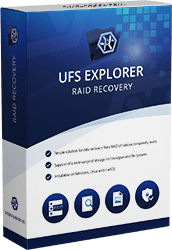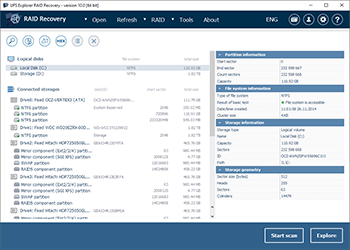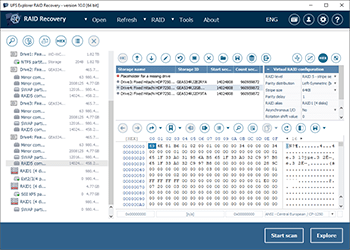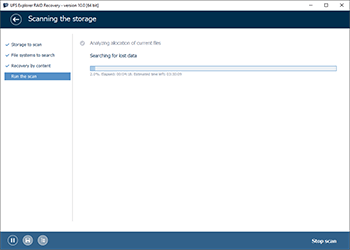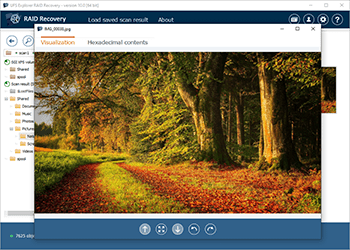UFS Explorer RAID Recovery

UFS Explorer RAID Recovery is a multifunctional computer program equipped to address a broad range of data loss issues, from the retrieval of files deleted from a hard disk drive or USB device to the reconstruction of custom RAID patterns utilized in servers, NAS or SAN units.
A universal solution for simple and complex data recovery tasks

deletion

corruption

formatting

crashes

attacks

defects
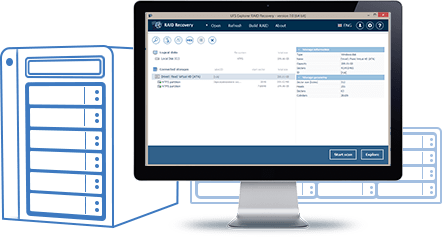
- PCs/laptops
- Hard disk drives
- External USB disks
- USB flash drives
- Memory cards
- Music players
- Digital cameras
- RAID sets
- NAS devices
- SAN systems
- Servers
- Other storage devices
 Documents
Documents Images
Images
 Audio files
Audio files Videos
Videos
 E-mails
E-mails Any other file format
Any other file format
Key features
UFS Explorer RAID Recovery offers the possibility to restore data from RAID of different configurations, among which are standard RAID levels (RAID 0, RAID 1, RAID 1E, RAID 3, RAID 5, RAID 6, etc.), nested patterns (RAID 10, RAID 50, RAID 60, RAID 50E, etc.) and custom RAID setups via RDL or Runtime VIM. The program also works with specific RAID sets, like Drobo BeyondRAID, Synology Hybrid RAID and Btrfs-RAID which makes it efficient in most instances of data loss related to complex storage systems.
Along with RAID units, the software handles other common storages, providing direct access to the available content and means for data recovery from internal and portable hard drives, memory cards, thumb drives, etc. of different formats used by Windows (FAT/FAT32/exFAT and NTFS), macOS (HFS+, APFS), Linux (Ext2/Ext3/Ext4, ReiserFS, XFS, JFS, IBM JFS2) and BSD/Solaris (UFS/UFS2, ZFS).
UFS Explorer RAID Recovery is capable of processing NAS appliances of such popular vendors as Drobo, Buffalo (TeraStation, LinkStation), Synology, QNAP Systems, etc. and is a perfect solution for cases involving Network Attached Storages. The application reads out RAID metadata from NAS drives and uses it for automatic reconstruction of its configuration. RAID can also be defined manually with the help of a specialized RAID builder.
The software is able to work with many storage technologies that can be found in modern computing devices, including Windows Dynamic Disks and Storage Spaces, Apple Software RAID and APFS-based Fusion Drive, Linux mdadm and LVM, virtual disks employed by major virtualization systems, like VMware, Hyper-V, VirtualBox, QEMU, XEN and others, as well as diverse formats of disk images.
UFS Explorer RAID Recovery provides several options for data access and allows choosing a timeout for cases when reading fails due to an I/O device error. With an embedded advanced tool for disk imaging, it is possible to adjust the imaged area and specify various parameters, like read timeout, block size, direction, protocol and settings for the omission of defective blocks. The bad blocks detected in the process get mapped in a dedicated file which can be used for other data recovery processes. Also, the instruments like an event log and S.M.A.R.T. monitor make it much easier to control the procedure.
The utility enables the adaptive reconstruction of redundant disk arrays (RAID 1, RAID 5, RAID 6, etc.) with the help of bad sector maps created for the constituents during of their imaging or through recognition of a predefined pattern and external maps generated by compatible third-party tools. The software identifies defective blocks on disks relying on the corresponding maps and can restore them using redundancy (parity information or a copy of data).
The software presents several variants of scanning, including a quick scan for defined file system types, a longer profound search for lost data by known content with an option to load custom IntelliRAW rules, scanning of the space occupied by the file system or just the “free space” areas. The scanning process can be paused with the possibility to check the intermediate results and can be saved for further references.
UFS Explorer RAID Recovery creates maps of defective blocks during disk imaging and supports ones produced by other compatible tools. The application can define virtual damaged blocks on the storage using such a map or identify them dynamically by looking for a specified content pattern. The faulty areas can also be masked with a given text or hexadecimal template.
UFS Explorer RAID Recovery is augmented with multiple auxiliary possibilities aimed at its convenience. Among them, you will find an advanced search function, an embedded viewer for files of popular formats, including images, PDF documents and text files, sorting and filtering options for items with different criteria.
What's New in Version 10.14
- Intel ISM configurations: fixed issue with detection on image files in some scenarios;
- Microsoft Storage Spaces:
- Added support of SPCACHE storage caching mechanism (used in recent Windows Server versions to speed up 'Parity' volumes);
- Automatic Storage Space assembly procedure is modified to support Transaction log or Cache (if available);
- Automatic procedure now can be configured to not assemble spaces, assemble just a plain volume or assemble with log/cache enabled (default);
- Fixed issue updating configurations with missing drives;
- ReFS file system:
- Fixed issue that caused duplication of files produced by the file system scan in some scenarios;
- Fixed issue with support of reparse points with a shorter metadata chain (ReFS version 3.14);
- Fixed issue displaying of some detected complex volumes (required additional 'refresh' operation);
- Added detection of deleted partitions when disk is initialized with an empty GPT (only 'Reserved' partition is defined);
- ExFAT scan: a couple of fixes for better recovery quality of folder structure.
Frequently asked questions
-
You can download the free Trial version of UFS Explorer RAID Recovery from this webpage and use it to make sure that the product corresponds to your requirements. The trial software will present all the recovered data and allow copying files with a size of less than 768 KB. Copying bigger files requires activation of the software license.
-
Recovery Explorer RAID may serve as a perfect alternative to UFS Explorer RAID Recovery for both beginners and advanced home users. Please refer to the comparison page to find out the difference in the functional capabilities of these product editions and decide which of them is a better match to your needs.
-
If you are interested in the difference between several UFS Explorer products, please, familiarize yourself with the following comparison table.
-
A license should be selected in accordance with the intended use of the software. The Personal License can be used by a single individual only for personal or educational purposes on home PCs or one computer at work. The Corporate License can be used on up to ten computers owned by a legal entity, company or organization for corporate non-profit or educational purposes. The Commercial License can be used on one computer owned by a legal entity, company or organization for commercial purposes and providing services. The Government and Academic Licenses may also be provided for use by eligible government organizations and educational institutions. For more detailed information please refer to the software licensing page.
-
The license for the software will be provided after a one-time payment of the corresponding license fee. To place an order use the "Buy License" button on this webpage or the "Order license" button from the "Software Activation and License" dialog in the software interface. Choose the needed license type and the operating system you are going to use for the installation of the software. Please note that a single license is applicable for a specific version of the product for one operating system (e.g. Windows OS, both 32-bit and 64-bit) and running the software in other environments requires activating different software licenses. Press "To Checkout" and fill out the billing form. The information needed for the purchase includes first name, last name, address, city, country and email address. All the data and the transaction will be securely processed by our sales partner 2Checkout according to the market security standards.
-
Our sales partner 2Checkout provides a variety of payment options, including Visa/MasterCard, PayPal, American Express, Discover, WebMoney, wire transfer, etc. and allows performing the payment in any currency. For more details, please, visit the global payments page on their website.
-
A Registration Code is issued to either the person's (entrepreneur’s) name or company's name once the payment is processed and is delivered to the email address specified in the order. The delivery is electronic and usually takes about 15-45 minutes.
-
A Registration Code will be sent to the email address specified in your purchase order. To activate the license, download a free Trial version of the software and enter your name with the Registration Code from the email in the "Software Activation and License" dialog.
Other UFS Explorer products
-
NTFS, FAT/FAT32, exFAT, ReFS/ReFS3;
-
HFS+, APFS;
-
Ext2, Ext3, Ext4, XFS, Extended format XFS, JFS, ReiserFS, UFS, UFS2, Adaptec UFS, big-endian UFS, Sun ZFS, Btrfs;
-
simple/stripe ZFS volumes.
-
NTFS:
full support: data access, search for lost partitions, RAID recovery, recovery of deleted files, recovery after formatting and file system damage. -
FAT/FAT32/exFAT:
full support: data access, search for lost partitions, recovery of deleted files, recovery after formatting and file system damage. -
ReFS/ReFS3:
full support: data access, search for lost partitions, RAID recovery, recovery of deleted files, recovery after formatting and file system damage. -
XFS:
full support: data access, search for lost partitions, RAID recovery, recovery of deleted files, recovery after formatting and file system damage; support of NAS devices and custom servers. -
Apple HFS+:
full support: data access, search for lost partitions, RAID recovery, recovery of deleted files, recovery after file system damage. -
APFS:
full support: data access, search for lost partitions, RAID recovery, recovery of deleted files, recovery after file system damage. -
Linux JFS:
full support: data access, search for lost partitions, RAID recovery, deleted files recovery, recovery after format and file system damage. -
Ext2-Ext4:
full support: data access, search for lost partitions, RAID recovery, recovery of deleted files, recovery after file system damage; support of NAS devices and custom servers. -
ReiserFS:
full support: data access, search for lost partitions, RAID recovery, recovery of deleted files, recovery after formatting and file system damage. -
Btrfs:
full support: data access, search for lost partitions, RAID recovery, deleted files recovery, recovery after format and file system damage. -
UFS/UFS2:
data access, search for lost partitions, RAID recovery for both little-endian and big-endian variations; recovery after file system damage; very limited recovery of deleted files. -
ZFS:
data access, search for lost partitions, data recovery from simple and stripe volumes, deleted files recovery.
-
Composite volumes: mdadm, LVM, LDM, Apple Software RAID, Intel Matrix;
-
Most standard RAID patterns: RAID 0, RAID 1E, RAID 3, RAID 4, RAID 5, RAID 6, etc.;
-
Nested (Hybrid) RAID levels: RAID 10, RAID 50, RAID 60, RAID 50E, etc.;
-
Non-standard RAID: Drobo BeyondRAID, Synology Hybrid RAID, Btrfs-RAID;
-
Custom RAID patterns: via RAID Definition Language or Runtime VIM;
-
Adaptive RAID reconstruction: RAID 5, RAID 6, RAID 5E, RAID 1, RAID 10, RAID 0+1 and nested RAID (levels 50, 51, 60, 61, etc.) using maps of bad sectors.
-
Virtual disks and disk images: VMware (VMDK), Hyper-V (VHD/VHDX), QEMU/XEN (QCOW/QCOW2), VirtualBox (VDI), EnCase (E01 and Ex01 non-encrypted), Apple Disk Images (DMG), disk images of DeepSpar DDI, R-Studio image files (RDR), simple disk images;
-
Other storage technologies: Microsoft Storage Spaces, Fusion Drive (based on APFS).
-
Tools for low-level data analysis: hexadecimal viewer (for storages, partitions and files);
-
Features for work with damaged disks: configurable drive reading procedure, advanced embedded disk imager, defining damaged regions using bad sector maps (created by UFS Explorer or compatible third-party tools –ACE PC-3000, DeepSpar DDI, etc.), S.M.A.R.T. monitor for drives, event log;
-
Auxiliary options: files preview, search, sorting, filtering and others.
-
The software will copy files the size of which doesn’t exceed 768 KB.
Microsoft Windows ®: starting from Windows® XP with Service Pack 3 and later;
macOS: all versions starting from 11;
Linux: Debian Linux 6.0 (or compatible) and above.
Intel Architecture, 32-bit (IA-32, x86);
AMD64 (x86-64);
-
Apple Silicon (arm64).
Any of the supported host operating systems;
at least 20 MB of free space on the disk for the executable files of the software;
at least 1 GB of RAM;
the Linux software version can run from most modern Linux Live CDs.
A 64-bit edition of any of the supported host operating systems;
over 1 GB of free space on the disk for the program and temporary files;
at least 2 GB of RAM and 4 logical cores CPU;
any web browser.
